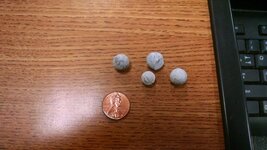scottrainey
Tenderfoot
- Jan 15, 2015
- 5
- 11
- Primary Interest:
- All Treasure Hunting
Hi, new member here.
I'm a middle school teacher in Washington State, in a community along the Columbia River across from Portland, Oregon. Our town is the site of a Lewis and Clark campsite, Cottonwood Beach.
A couple days ago, a student of mine found some small objects, apparently made out of lead, in the sand at Cottonwood. Unable to identify them, I thought I'd post photos here and see what you all might know.
(I don't pretend to think they are possibly from the Lewis and Clark camp, but I'm still at a loss as to what they might be). Any thoughts? Lead fishing weights, perhaps?
I'm a middle school teacher in Washington State, in a community along the Columbia River across from Portland, Oregon. Our town is the site of a Lewis and Clark campsite, Cottonwood Beach.
A couple days ago, a student of mine found some small objects, apparently made out of lead, in the sand at Cottonwood. Unable to identify them, I thought I'd post photos here and see what you all might know.
(I don't pretend to think they are possibly from the Lewis and Clark camp, but I'm still at a loss as to what they might be). Any thoughts? Lead fishing weights, perhaps?

Upvote
3







